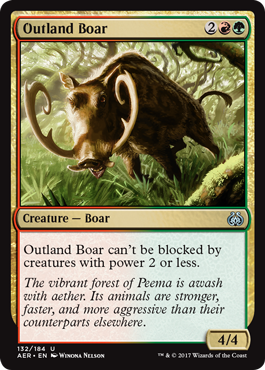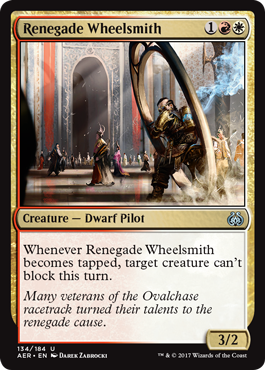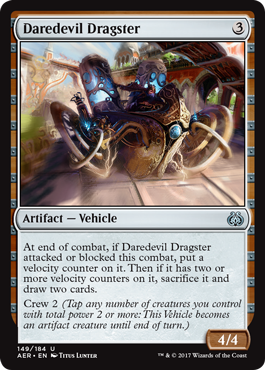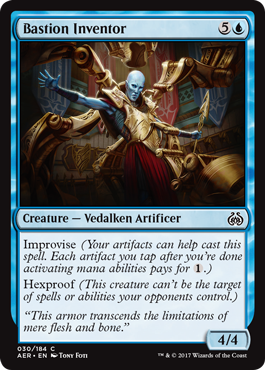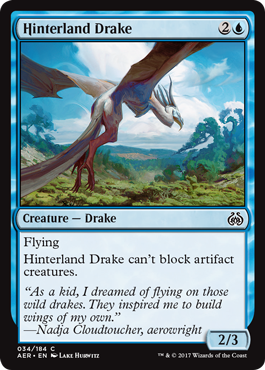The Aether Revolt prerelease is coming up this weekend. As a big fan of Kaladesh Limited, I’m excited to see what the additional set brings to the table. Kaladesh draft was full of powerful, aggressive decks, but the format was balanced so that slower and more controlling decks could compete. This strikes me as a big level up in Limited design and development over previous fast draft sets like Zendikar and Gatecrash. In Kaladesh, you really can do whatever you want, including bashing face.
Kaladesh draft has been defined by the tension between Renegade Freighter and Prophetic Prism. Aggression and control are well-balanced. It doesn’t matter so much which you prefer, so long as you understand how to read signals and see which cards fit into the faster or slower decks. The powerful cards that fit easily into both styles, like Welding Sparks, get taken very early.
How did Kaladesh manage to balance the powerful aggression of Renegade Freighter against the multicolor nonsense of Prophetic Prism? I’ve developed a concept to explain how this works. I call it “tempo” evasion. Here’s the basic idea: efficient creatures that are hard to block effectively have “evasion” when you curve out and keep attacking your opponent. These same creatures become normal ground creatures that can be easily blocked after the game has stalled out.
Creatures with tempo evasion enable aggressive decks to win quickly and build advantages on board. But if the controlling deck can stymie those creatures and stabilize, it can rely on its slower game plan to win. Even then, the tempo evasive creatures are still good enough to be relevant late—they just can’t attack through blockers as easily as creatures with permanent evasion like flying can. Renegade Freighter is the perfect example of a tempo evasion card. In the early turns, you are hard pressed to block a 5/4 trampler. A few removal spells handle it efficiently, but even if you mana to throw four power in front of it, there’s a good chance you only got two or three toughness to block, leaving you a few damage down in the exchange. By turn eight, freighter isn’t so fearsome, but it still demands respect.
What does Aether Revolt have to say about this?
Here’s an example of a four drop with tempo evasion. Outland Boar is big. A 4/4 for four mana in red-green isn’t undercosted exactly, but it’s quite efficient. That’s essentially its ability: five mana worth of power and toughness for one less mana, as if it’s special ability is a bonus +1/+1 counter. A 4/4 is tough to block on turn five, especially if you’ve been attacking with two and three power creatures on your previous turns. But Outland Boar also has an additional ability: it can’t be blocked by small creatures. As we’ve seen on Elegant Edgecrafters and Ghirapur Guide, this is a decent ability to have. It is more tempo evasion: early in the game it is harder to have creatures big enough to block the boar, while later on a Bastion Mastodon and some 3/3s can hold down the fort. Boar isn’t exactly better than Peema Outrider—another great card with tempo evasion—but redundancy is what makes aggressive decks powerful.
Red white is another aggressive color pair from Kaladesh. No surprise that, like red-green, it gets a powerful aggressive uncommon gold card. A 3/2 for three mana is the norm for aggressive creatures in Kaladesh, which plays into the aggressive style. Renegade Wheelsmith gets an additional evasive ability that can remove a blocker each turn, and it even comes with haste if you crew a vehicle the turn you play the wheelsmith. Removing one blocker loses value as the game goes long, unless you can keep the board clear; but playing this on curve in a red-white vehicles deck, or even playing it on turn five after building a board and having mana left for tricks, will make it very difficult for your opponent to block effectively.
Here’s a funny card that gives a little take on tempo evasion. A three mana 4/4 is above curve, but after attacking with it twice, you have to cash it in for two cards. I think most aggressive decks would rather just keep the 4/4 around than trade it in for two more cards, but after swinging for eight damage, maybe you want to move on to other threats that can finish the game. Besides, your opponent will probably try very hard to kill this in combat on it’s second attack, throwing plenty of blockers in its way, giving you the opportunity to wreck them with Built to Smash or the like. You’d probably still rather keep the 4/4 in that situation, but the format has to stay fair for slow decks too.
As short-term “tempo” evasion takes center stage for aggressive decks, what happens to slower decks? They tend to want to clog up the board and then win with truly evasive threats. First, control decks need a way to catch up on mana. It turns out Aether Revolt has the perfect mechanic for this: improvise. And early Prophetic Prism and Implement of Examination help power out undercosted improvise creatures and cut the mana on big draw spells. Some of the improvise finishers also happen to have flying., which plays into the second need for control decks. Wind-Kin Raiders could be a better Long-Finned Skywhale for slow blue artifact decks.
Perhaps the most subtle design of the new set, my favorite card in Aether Revolt is Hinterland Drake. There’s a long history of Wind Drake versus Scrapskin Drake. Giving up some blocking ability to get a third point of toughness tends to be a bad deal, but I think the opposite is true in Kaladesh. Triple-Kal was a horrible format for Wind Drake, which never fit in blue. It couldn’t attack efficiently to close the game for control decks and it didn’t do enough to slow the other deck down either. Ironically, the new white Ghirapur Osprey is much better-positioned, because white has more ways to augment it’s creatures and strong aggressive cards anyway.
Hinterland Drake looks great for Aether Revolt to me, and a big improvement for blue over Wind Drake. It may not be able to block artifact creatures, but it sure can block other stuff, and can hold off 2/2s without trading. Wind Drake is only good for attacking in this format, but it isn’t efficient enough to do that well most of the time. Hinterland Drake adds a little toughness to make it useful before needing to turn sideways, making it more appealing for control. It won’t match up well against thopter tokens, but a good control deck needs to have a plan for thopter armies anyway. Hinterland Drake fills other roles.I’m excited to see how it plays out.
Good luck at your prerelease. Think about tempo evasion this weekend and let me know how it works out.
Carrie O’Hara is Editor-in-Chief of Hipsters of the Coast.


